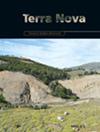Imaging of post‐collisional deformations on the NE Tisza continental unit using ambient seismic noise: A case study from the Țicău area, Romania
IF 1.7
3区 地球科学
Q2 GEOSCIENCES, MULTIDISCIPLINARY
引用次数: 0
Abstract
The Ţicău area (NW Romania) is part of the collisional zone between the Tisza and Dacia mega‐units. Imaging of Ţicău area's subsurface geological structure will contribute to the understanding of the processes, which controlled its tectonic evolution. Analysis of outcrops provides accurate information for the building of kinematic sections used to explain the small‐scale deformations of sedimentary formations, such as those developed south of the Ţicău mountains. Imaging of large‐scale deformations requires analysis of data recorded and/or measured over a wider area. We use Seismic Interferometry by cross‐correlation on ambient noise recorded along with a line located north of the Ţicău mountains. The passive seismic section obtained after virtual body‐wave reflections processing displays folded and faulted Paleogene formations, which are in good agreement with the observations on outcrops found to the south of the Ţicău mountains. The active‐source data recorded along with the same line are too noisy for interpretation.使用环境地震噪声对NE Tisza大陆单元碰撞后变形的成像:罗马尼亚Țicău地区的案例研究
Ţicău地区(罗马尼亚西北部)是Tisza和Dacia巨型单元之间碰撞带的一部分。对Ţicău地区地下地质结构的成像将有助于理解控制其构造演化的过程。露头分析为建造运动学剖面提供了准确的信息,用于解释沉积地层的小规模变形,例如在Ţicău山脉以南开发的沉积地层。大规模变形的成像需要对在更大范围内记录和/或测量的数据进行分析。我们通过对沿Ţicău山脉以北的一条线记录的环境噪声进行互相关,使用地震干涉测量法。经过虚拟体波反射处理后获得的被动地震剖面显示了褶皱和断裂的古近系地层,这与在Ţicău山脉以南发现的露头观测结果非常一致。沿着同一条线记录的活动源数据噪声太大,无法进行解释。
本文章由计算机程序翻译,如有差异,请以英文原文为准。
求助全文
约1分钟内获得全文
求助全文
来源期刊

Terra Nova
地学-地球科学综合
CiteScore
4.80
自引率
8.30%
发文量
59
审稿时长
2.3 months
期刊介绍:
Terra Nova publishes short, innovative and provocative papers of interest to a wide readership and covering the broadest spectrum of the Solid Earth and Planetary Sciences. Terra Nova encompasses geology, geophysics and geochemistry, and extends to the fluid envelopes (atmosphere, ocean, environment) whenever coupling with the Solid Earth is involved.
 求助内容:
求助内容: 应助结果提醒方式:
应助结果提醒方式:


